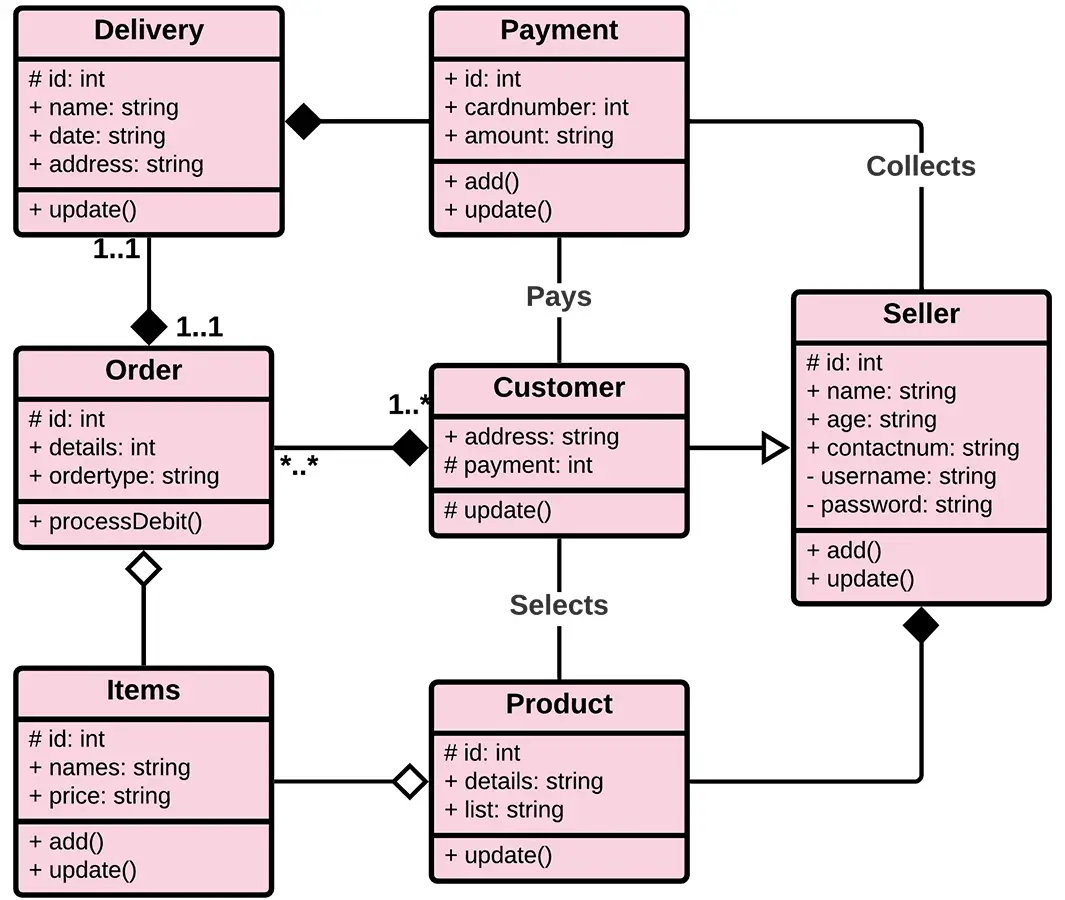The Class Diagram for e commerce Website is a form of structural (UML) diagram that depicts the website’s structure. This is designed by displaying the e-commerce website’s classes, attributes, methods, and relationships between classes.
Class diagram reveals the class structure blueprint of E-commerce Website. It is used to model the items that make up the software and depict their relationships. This is to define the function of a class and the operation it provides.
E-Commerce Website Class Diagram: Project Name and Details
The table shows the name and details of e-commerce website class diagram. It has the complete information on project components and diagraming tools.
| Name: | E-commerce Website Class Diagram |
| Abstract: | The E-commerce Website Class Diagram represents the structure of the project in terms of its classes. It contains the important details on the data characteristics present in the project. |
| UML Diagram: | Class Diagram |
| Users: | Buyers (Customer), Seller, and Website Admin |
| Tools Used: | Diagram tools that provides class diagram symbols. |
| Designer: | ITSourceCode.com |
Importance of Class Diagram for E-commerce Website
The Importance of Class Diagram for E-commerce Website is that it helps in visualizing the classes that make up the website. It displays the classes’ connections and reports their characteristics, operations, and methods used.
Class diagram helps you understand the project’s classes. It gives you a lot of information on the structure of your website. It also provides a rapid summary of the synergy that occurs among the various website’s classes, as well as their qualities and interactions.
The class diagram aims to show the software’s static view. This diagram can be mapped with object-oriented languages, making it appropriate during the construction process.
UML Class Diagram for E-commerce Website
The UML Class Diagram for E-commerce Website describes an entity or a group of objects with similar structure and characteristics. A box with three rows is used to represent them.
The class diagram is presented in a rectangle with three partitions. The upper part is for the name of the class, the middle is for its attributes and the bottom is for the methods. These partitions will clearly emphasize the details of the classes.
Class diagrams provide the same basic goals as the other UML diagrams. They are one of the most useful forms of UML diagrams because they clearly map out a website’s structure by representing its classes, characteristics, operations, and relationships. Creating these diagrams isn’t as difficult as it may appear with the UML diagramming tools.
E-commerce Website Class Diagram: Benefits
The E-commerce Website Class Diagram Benefits are as follows:
- It aids in the better and more accurate illustration of data models.
- Explains more straightforward and clear understanding of the overall software or process’ overview and schematics.
- It provides a sense of direction.
- Gives a lot of information on the structure of your software.
- Summarize the software’s static perspective.
- Enumerates how the parts of a static view work together.
- Defines the functions that the software does and Object-oriented programming languages are used to create its applications.
Simple (UML) Class Diagram for E-Commerce Website
The Simple (UML) Class Diagram for E-Commerce Website is constructed with the simple idea derived from the common function of an e-commerce. This Class Diagram gives you the exact details about the class characteristics and methods. It is given to expound its ideas, clarifies the connections of classes in the website.

The classes identified for E-commerce Website were the seller (admin), customer, items, product, orders, payment, delivery, and transaction. Their roles were explained in the middle part and called as their attributes. The function can be seen by reading through its’ methods.
You can add more to this and it is up to you on how will you create your class diagram. Only be precise with your information and consider the decisions that should be included.
Steps in Creating Class Diagram for E-commerce Website using UML Tool
Time needed: 5 minutes
Steps in creating Class Diagram for E-commerce Website is elaborated here.
- Step 1: Familiarize Class Diagram Components
Class Diagram Components – are used to create Class Diagram which were presented here. they should be familiarized before you build the Class Diagram.
Class Name : The name of the class appears in the upper portion. Whether you’re talking about the classifier or an object, this portion is always essential.
Class Attributes : The class’s attributes are found in the middle portion. Use this section to describe the class’s characteristics. When specifying a specific instance of a class, this is only required.
Class operations : are included in the bottom part (methods). Each action has its own line when displayed in a list format. The operations are the methods by which a class interacts with data.
Class Connections : Depending on the access modifier, each class has a different level of access (visibility). The following are the access levels and the symbols that correlate to them:
• Public (+)
• Private (-)
• Protected (#)
• Package (~)
• Derived (/)
• Static (underlined)
Each of these class diagram components shows the overall Class structure. Emphasizing the website’s structure would be much easier by using these Class Diagram symbols. - Step 2: Determine the targeted users
After the symbol familiarization, you’ll need to determine your targeted users. Your targeted users will be the ones to use your project.
Your project is e-commerce website, then your users would be the Seller, Admin and the Customers. You may ask them of the common activities that they do when doing task in recognizing faces. These information will help you in proceeding with the next step. - Step 3: Analyze the activities included
Analyzation is very important in creating an class diagram. It will help you understand the work of the diagram and avoid the unwanted errors.
The gathered information from the targeted users are very useful in creating an class diagram. You just need to evaluate these data and pick the useful classes. Then you’re ready for the next step. - Step 4: Plot the Class Diagram
To plot the class diagram you will need the class name, its attributes, methods, and their access (visibility). You will base the diagram from the evaluated information to have the exact Class Diagram.
To plot your Class diagram, you need to place first the classes and their characteristics.
Then place the visibility of the class’ attributes. You will declare their visibility into the project to know their function.
Finally, put the connections or relation of a class to the other classes to make sure they are working to produce the desired outcome.
Bonus Tips for E-Commerce Website UML Class Diagram
To design your Class diagram, you may use platforms and editing tools online. These tools are helpful since they already have the needed symbols to illustrate your class diagram. You just have to plot the included classes, attributes and methods. Then you will put the appropriate relationships that the software requires.
The platforms or online tools that you may use are:
• Lucidchart
• Creately
• Smartdraw
• Edrawmax
• Canva
Conclusion
The E-Commerce Website is a modeled diagram that explain its classes and relationships. The diagram depicts the names and attributes of the classes, as well as their links, and their methods. It is the most essential type of UML diagram which is critical in software development. It is an approach to show the website’s structure in detail, including its properties and operations.
The E-Commerce Website must have a designed diagram to define the classes needed for the desired outcome. It is used to model the items that make up the website, depict their relationships, and define what those objects perform and the services they provide. And that completes our discussion fellas! I hope that this article about UML Class Diagram for E-Commerce Website will help you a lot.
Related Articles:
- E-Commerce Website UML Diagrams [Complete]
- Use Case Diagram for E-Commerce Website
- E-Commerce Website Activity Diagram
- Sequence Diagram for E-Commerce Website
- ER Diagram for E-commerce Website
Inquiries
If you have inquiries or suggestions about E-Commerce Website Class Diagram, just leave us your comments below. We would be glad to hear to concerns and suggestions and be part of your learning.
Keep us updated and Good day!

